Other Invasive Weeds
Giant hogweed
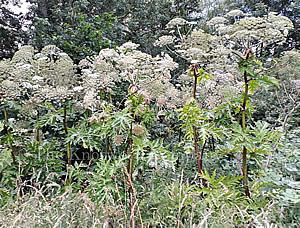
Giant hogweed (Heracleum mantegazzianum) is one of the largest herbaceous plants in this country and certainly one of the most harmful to human health. It is invasive, producing thousands of seeds from each plant. Its size makes it particularly attractive to children to play around, leading to severe burn injuries every year.
It is generally regarded as a short-lived perennial, typically taking between 3-5 years to reach maturity, flower, set seeds and die. However, in less than optimum conditions, or as a result of disturbance, it may take up to 12 years to complete its life cycle. In its early years, it may be lost among other vegetation and can easily be overlooked, but in its final year it can grow over 5m in height before flowering. A single plant may set between 20,000 and 50,000 seeds.
Giant hogweed is (or should be) a serious concern for land owners, as the sap photosensitises on human and animal skin. Severe and painful burns are common following exposure and full recovery from these effects can take months or even years; permanent scarring of the skin could also result. More severe effects of exposure to the sap are not unknown: blindness (permanent or temporary) has been reported, as has death. To be affected by giant hogweed takes simple contact with either the sap or the hairs on the leaves and stems – and the sap can soak through clothing. Therefore, ANY exposure to this plant can lead to harm. The sap does not irritate or burn and so victims can often be left unaware that they have been affected until it is too late. The burns and blisters appear several hours later and are worsened by the length of time a person continues to be exposed to the sun’s rays after contact with the giant hogweed.
If anyone has been exposed to the sap, recommended first aid includes:
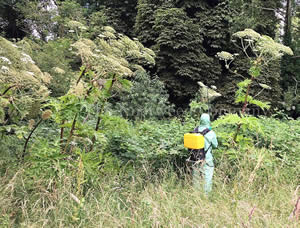
Treatment of the giant hogweed plants is a fairly simple matter in that it is susceptible to several professional herbicides. It can be killed quite successfully, following 1-2 treatments, especially if it is treated in its earlier leafy state prior to producing any stems and flower heads. However, it does require a suitable risk assessment and protective clothing is required. Such clothing may need specialist disposal if contaminated with giant hogweed sap.
While the growing plants may readily be killed, the dormant seeds may take up to 5 years to grow, so annual visits to kill new seedlings will be required for at least this period if any giant hogweed is likely to have seeded previously in the area. If the giant hogweed was situated next to a waterway, future re-establishment of new seeds is always a possibility if hogweed remains untreated further upstream.
On construction sites (and other sites where the timescale for treatment is limited), other methods (such as excavation and disposal) can be considered. However, all treatments require an initial herbicide treatment and at least 3-4 weeks to allow the plant to die before works can start safely.
The Knotweed Company are experienced in the treatment and removal of giant hogweed. Please contact us if you require assistance in this regard.
Common ragwort
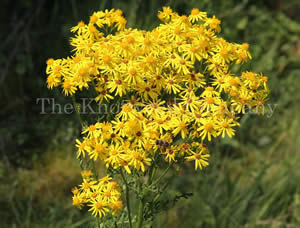
Common ragwort (Senecio jacobaea) is an emotive subject, especially among horse owners. It is a commonly held belief that common ragwort is the most frequent cause of animal poisoning in the UK, though such a claim has never been proven. What cannot be denied is the toxicity of ragwort and the devastating effect it can have on any susceptible animal that ingests it.
Ragwort is a native species and forms an important contribution to the biodiversity of the flora and fauna of the British countryside. It supports many species of wildlife, from fungi to invertebrates, and is vital for providing a food source for feeding insects in the late summer. A number of rare species confine themselves specifically to ragwort, including the distinctive black with gold stripe caterpillars of the Cinnabar moth (Tyria jacobaeae). This rich diversity of insects in turn provides a food source for birds and mammals. Therefore, obliterating ragwort from the face of the earth would have a detrimental effect on our wildlife and local eco-systems.
Ragwort is widespread throughout the UK. The common places to find it are on wasteland, development land, roadside verges, railway land, amenity land, conservation areas, woodland, grazing land and poorly managed pasture land. It is tolerant of a wide range of soil types and climactic conditions, though its preference is for soils of low fertility – particularly in areas that have previously been under-grazed or over-grazed.
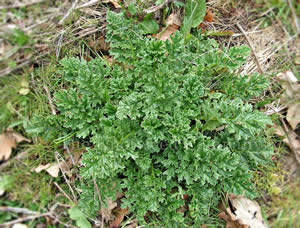
Common ragwort is normally a biennial (two-year life cycle), but under certain conditions it can live for longer. In its first year it will form ‘rosettes’ – profusions of low-lying spreading leaves around a central stem – that will remain throughout the first winter. In the second year, much of these leaves will die away as the plant sends up one or more erect stems that turn to striking, yellow, daisy-like flowers later in the year (typically around June). Each stem can produce numerous flower heads and seeds are produced as the flowers begin to fade in September/October. The plant will usually die off at this point to make way for immediate colonisation by the seedlings, which are borne by the wind to surrounding areas. Individual plants can produce up to 150,000 seeds. Seeds have an average germination rate of 70% and they have the ability to remain in a dormant state for up to 20 years before producing growth.
Ragwort contains pyrrolizidine alkaloids. These are highly toxic when ingested, particularly to horses, though other animals, such as sheep and cattle, can also be affected. The results of ragwort poisoning can be debilitating and potentially fatal, and can occur at any time of year. Ragwort acts as a cumulative poison, eventually destroying the liver, and a small intake of ragwort over a long period can be just as damaging as a large intake on a single occasion. Clinical symptoms of poisoning by ragwort include loss of condition (weight loss, dull coat, depression), poor appetite and constipation, photo-sensitisation (sunburn) and sometimes jaundice. The development of nervous behaviour, restlessness and aimless uncoordinated movement are some of the common terminal symptoms. Animals may appear blind, press their heads against solid objects and develop an abnormal gait and stance. Animals can die after as little as a week, though some can survive several months. Little can be done for an animal once the clinical symptoms appear.
Grazing animals will usually avoid eating growing ragwort due to its bitter taste. However, it is much more palatable when dead, so wilted or cut ragwort presents the greatest risk. The poisons are not weakened in any way by the condition of the plant and so it is vitally important for the health of livestock that dead or dying ragwort does not become mixed up with dried grass, hay or silage. In such situations it can remain undetected and be readily consumed. There has also been a suggestion that humans can be at risk from ragwort poisoning, though evidence for this is not in abundance. However, it is a wise precaution for anyone who regularly comes into contact with ragwort, particularly through hand-pulling operations, to ensure they always wear suitable protective clothing, such as non-absorbent gloves, to prevent their livers being affected in the long-term by the ragwort toxins.
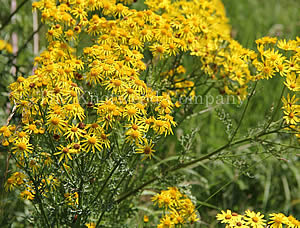
An initial attempt to actively control ragwort was its inclusion in The Weeds Act of 1959, whereby the Secretary of State for the Environment, Food and Rural Affairs could serve a notice on any land owner where ragwort is found to be growing to compel them to prevent its spread. Priority is given to any sites where there is a high risk of ragwort spreading to land used for the grazing of horses or livestock, or to land used for the production of fodder for horses or livestock. Failure to comply with such an order could lead to prosecution. Responsibility for the control of ragwort rests with the owner of the land on which it is growing.
The Ragwort Control Act 2003 was an amendment to The Weeds Act and resulted in the production of a Code of Practice, published in 2004, to control (but not eradicate) the spread of ragwort in the UK. Under the Code of Practice, ragwort locations are assessed by the level of risk they present to land used for grazing or fodder production. The Code also provides advice on prevention measures to help minimise the risk of spread.
Where treatment of ragwort is required, pulling methods can be effective (if labour-intensive), though may have limited long-term results. The use of an approved herbicide can provide a much better outcome, though is more effective if carried out when the ragwort is still in its initial ‘rosette’ stage. Treatment of ragwort requires careful management in grazing fields, since killing off the plants will make them more palatable to grazing animals but will not kill off their toxicity.
The Knotweed Company can provide treatment of ragwort areas where such control is required and will not run the risk of harming livestock after the ragwort plants are dead.
Himalayan balsam
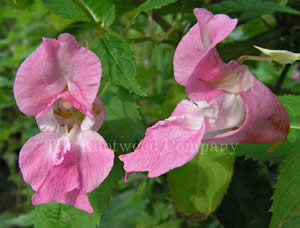
Himalayan balsam (Impatiens glandulifera) grows in dense colonies and thrives in moist environments. It is most often found along rivers, streams, lakes and in damp woodland environments. It dominates any area where it becomes established and can be responsible for riverbank erosion during the winter when the plants die off. This can have a detrimental knock-on effect on various aspects of riparian ecology. It is also highly attractive to pollinating insects, usually to the detriment of surrounding competing species.
Himalayan balsam is the tallest growing annual weed in the UK (an annual plant is one that grows from seed, flowers and dies within the same growing season). Height can vary, with some plants as small as 30cm and others up to 3m when flowering. Flowers are distinctive, with their elegant slipper shape leading to one of the plant’s colloquial names; ‘Policeman’s Helmet’. Colours of the flowers can vary, from white to a dark pink/purple, and they are in evidence by mid-summer.
Seed pods form around June or July and they swell and distend as the seeds develop within them. Each seed pod typically contains between 4 - 16 seeds and it is possible for each individual plant to produce up to 2,500 seeds. When the seed pods are ripe, any disturbance of them triggers the explosive release mechanism – walking through a dense colony with ripe seed pods can be an interesting experience! Seeds are often transported by rivers and streams (reaching over 10 km in some cases) but can also be spread by human interaction.
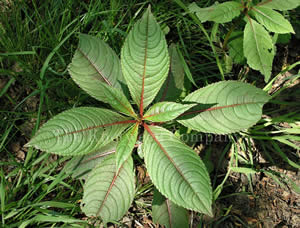
Control measures are quite straightforward. There are mechanical methods, in which the plants are either pulled up or cut to ground level before they set seed (commonly referred to as 'balsam bashing') or chemical methods using an approved herbicide. The seed bank persists for 18 months to 2 years, so control measures must continue for this period.
Consideration of reinfestation from outside of the site must always be considered. On riverbanks, if balsam is thriving upstream, each year will see a new supply of seeds washing up on the bank. Seeds can also be spread by animals, people, etc. and so it is possible ongoing annual control measures will be required each spring or early summer to keep the balsam at bay. Revegetation, particularly of riverbanks, should also be considered following balsam removal to prevent erosion and to reduce the risk of future reinfestation.
The Knotweed Company can provide survey and treatment options for Himalayan balsam as required.
Field horsetail
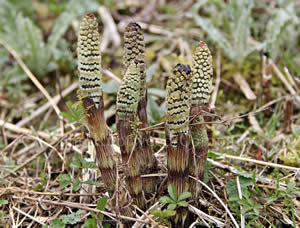
Field horsetail (Equisetum arvense) – the scourge of the allotment owner – is often referred to erroneously as mare’s tail. It is a relatively slow-spreading species. However, once it has become established, it forms dense colonies and can prove to be almost impossible to get rid of. It is an extremely old species, dating back millions of years, and is descended from a group of tree-like plants that grew back in the Carboniferous period (around 300 million years ago).
Field horsetail and mare’s tail (Hippuris vulgaris) are two distinctly different but related species, though are often interchanged in conversation as if they are common names for the same plant. Mare’s tail is a strictly aquatic plant whereas field horsetail, whilst preferring moist conditions, can usually be found growing on land. Also, mare’s tail produces flowers, whereas field horsetail does not. Though neither are native species, both mare’s tail and field horsetail form an important part of the natural biodiversity in the UK and should only be eradicated in areas where their eventual domination of the vicinity will cause a problem. Therefore, control is required more in areas of human activity than in the natural environment.
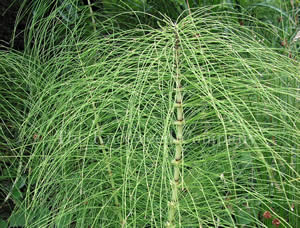
Field horsetail is a perennial (i.e. lives for three or more years) and spreads by means of rhizomes that are often too well rooted to successfully dig out without mechanical assistance. These rhizomes can reach as deep as 2 metres below the surface, are black to dark brown in colour and are often difficult to spot in the soil (and therefore extremely easy to accidentally sever) if attempts are made to dig them out. Severed rhizomes can regenerate to produce new growth.
Horsetail produces two distinct forms of top growth. The first, produced during the spring, is a long, roughly cone-shaped structure around 2.5cm in height that appears at the top of a tough, wiry stem. From these structures millions of spores are released, which spread the plant quite effectively to adjacent areas. Once the spores have been released, the stems die off and are replaced by taller (up to 60cm), dark green shoots that, once matured, develop into the better known distinctive horsetail shape. The ‘leaves’ that sprout from the stem are whorled, green, needle-like branches that are slightly reminiscent of horse’s tails or bottle brushes. These die off in late autumn, and horsetail survives the winter by storing all of its nutrients within the substantial rhizome system.
Although horsetail has been regarded as a useful species – being used in ancient civilisations for cleaning pots and polishing wood, and seen to have great medical benefits by the Romans, Greeks and Chinese – it is seen today (as with common ragwort) as a threat to the health of livestock – especially horses. Whilst having only a moderate toxicity to most animals, horses are seen to be particularly susceptible to the Thiaminase toxins found within the plant tissue. All parts of the plant are toxic whether eaten fresh or dried, although dried plants may be more poisonous. Clinical indications of horsetail poisoning can include weight loss, depression, unsteady gait, muscle twitching, inability to stand, constipation and seizures. Horsetail poisoning can lead to death if the animal is not properly treated. It has been calculated that only three weeks of a diet comprising 20-25% horsetail can lead to clinical symptoms. Another impact horsetail can have is to cause damage to the built environment. Shoots can exploit weaknesses in man-made structures and it is not uncommon to find horsetail growing through tarmac or cracked concrete.
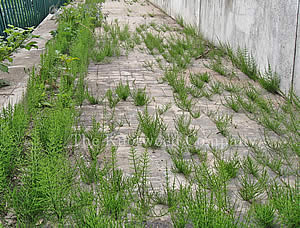
Field horsetail is almost impossible to eradicate. Digging out usually results in rhizome fragments remaining in the soil, so the plant simply grows back again – usually with an increased number of shoots. The plant is highly resistant to herbicides, with most having little effect other than burning off the outer surface of the branches. In areas where the spores are allowed to be produced, substantial spread can be seen the following growing season. The use of heavy duty specialist root barriers can help protect vulnerable surfaces and it may be useful to lime the soil to increase the pH, as this will assist in limiting horsetail growth.
The Knotweed Company can provide advice and assistance in the control and containment of horsetail growth, but cannot offer guaranteed treatment programmes due to the unpredictable long-term results of such programmes.
Buddleia
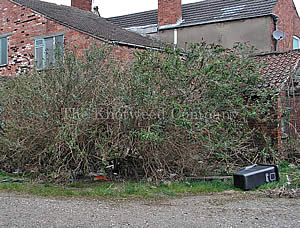
Buddleia is a popular ornamental plant to be found in many gardens. Often hailed as a boon to the environment, buddleia has a dark side. It is highly invasive, destructive to the built environment and not nearly as beneficial to butterflies as some imagine.
There are around 100 species of buddleia, with the most popular being common buddleia (Buddleia davidii). Originating in Japan and western China, buddleia was imported into the UK during the nineteenth century as a garden ornamental. Buddleia davidii was first recorded in the UK at Kew in 1896. It is an extremely hardy plant and can tolerate almost any growing conditions except full shade.
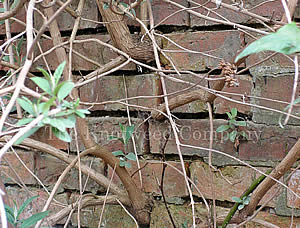
On average, buddleia grows to around 2.5m to 3m in height and spreads to between 1.5m to 3m wide – although larger sizes have been recorded. If left uncontrolled, buddleia can quickly come to dominate a site, outcompeting other species, and can often be found in derelict or run down areas. Between September and October, it produces an abundance of long brown fruits that split to release between 50-100 seeds from each fruit – an average of up to three million seeds per plant – which are widely distributed by the wind or along waterways.
Buddleia is responsible for more structural damage than Japanese knotweed. Seeds can grow in the smallest of cracks, without access to soil, and will develop large woody root networks that damage the structures from within. It is particularly damaging to the railway network, where it hinders maintenance and damages infrastructure. It weakens bridges, interferes with overhead powerlines and obscures signals.
Although hardy, buddleia can be easily killed off with herbicides or by digging out – though any roots present within walls (for example) can only be removed by the partial demolition of the wall. Cutting back the plant will achieve very little in the long-run, though control can be maintained by pruning all of the flower heads in the autumn or early winter as the flowers die off (i.e. before the fruits split to release the seeds). To prevent spread and potential damage to walls, buildings, pavements, drains, etc. it is important to prevent new seed production and to be vigilant for new seed growth that has blown in from elsewhere. Treat or pull up new growth to prevent establishment.
The Knotweed Company can provide advice and treatment options for buddleia if required.
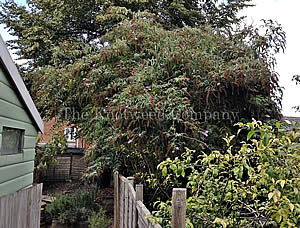
Buddleia is often referred to as ‘the butterfly bush’, due to the proliferation of butterflies to be commonly found on the plant. While true that it provides an important source of nectar for adult butterflies, moths and other insects, it cannot provide the rich variety of nectar to be found in naturally-occurring wild flowers. Also, buddleia provides no sustenance for caterpillars, meaning it cannot support a full life cycle for butterflies. Consequently, where buddleia is allowed to dominate an area, important butterfly habitat is eliminated. This, in turn, affects non-butterfly species (e.g. species of bird that feed on caterpillars).
The Butterfly Conservation Trust issued a position statement in 2012 on the planting of buddleia. It concluded buddleia could be planted in domestic gardens if properly maintained to prevent the dispersal of seeds but should not be planted “in semi-natural habitat re-creation schemes or in positions where it may be unmanaged and pose a risk to nearby wildlife habitats.”
Please read our cookies and privacy policy here
Copyright © 2018 · All Rights Reserved ·